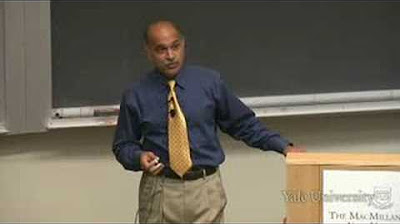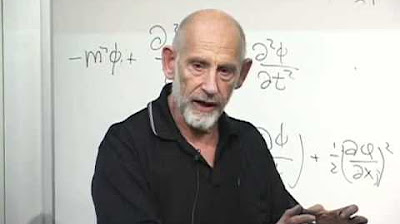2015 AP Physics 1 free response 5
TLDRThe video script discusses a physics experiment involving strings attached to oscillators and blocks, with a focus on understanding the fundamental frequency and its relationship with the properties of the string, such as tension and mass density. It explains that the fundamental frequency is the lowest frequency that produces a standing wave in the string and that this frequency varies with different strings due to their unique linear mass densities. The script also explores the non-linear relationship between frequency and the inverse of linear mass density, and concludes with a discussion on identifying points of greatest average vertical speed when a string vibrates at its second harmonic.
Takeaways
- 📈 The fundamental frequency of a string is the lowest frequency that produces a standing wave.
- 🎵 Standing waves on a string have specific wavelengths, with the fundamental frequency corresponding to a wavelength twice the string's length.
- 🌀 The velocity of a wave on a string is determined by the square root of the tension divided by the linear mass density of the string.
- 🔄 For strings with the same tension and length, different fundamental frequencies imply different linear mass densities or masses.
- 📊 A graph of frequency versus the inverse of linear mass density is not linear due to the square root and reciprocal relationships involved.
- 🌟 When a string vibrates at its second harmonic, the wavelength is equal to the length of the string,不同于 the fundamental frequency.
- 🚀 The parts of the string with the greatest average vertical speed during second harmonic vibrations are at 1/4 and 3/4 points along the string's length.
- 🔧 Tension in the string is provided by the weight of the attached masses, assuming the masses and string lengths are the same for comparison.
- 📐 The linear mass density (mass per unit length) affects how easily a string can be accelerated, and thus the wave velocity.
- 🌈 As tension increases, wave velocity on the string increases, allowing for more effective wave transmission.
- 📉 An increase in linear mass density results in a decrease in wave velocity due to increased inertia against acceleration.
Q & A
What is the fundamental frequency of a string?
-The fundamental frequency of a string is the lowest frequency at which a standing wave can be produced in the string.
What does a standing wave look like at the fundamental frequency?
-At the fundamental frequency, a standing wave in a string looks like a single half-wavelength, with the ends of the string remaining stationary and the center point moving the most.
How does the mass of the objects attached to the strings affect the fundamental frequency?
-The mass of the objects affects the fundamental frequency because it contributes to the linear mass density of the string system. Higher mass per unit length results in a higher inertia, leading to a lower fundamental frequency.
What is the relationship between the tension in the string and the wave velocity?
-The wave velocity on a string is directly proportional to the square root of the tension in the string. Higher tension leads to increased wave velocity.
Why do the four strings in the setup have different fundamental frequencies?
-The four strings have different fundamental frequencies because they have different linear mass densities, which is due to the different masses attached to them, given that all other variables affecting the fundamental frequency are the same.
What is the equation for the velocity of a wave on a string?
-The equation for the velocity (v) of a wave on a string is given by v = √(T/m)/L, where T is the tension of the string, m is the mass per unit length (linear mass density), and L is the length of the string.
How would the graph of frequency as a function of the inverse of linear mass density appear?
-The graph of frequency as a function of the inverse of linear mass density would not be linear. It would involve a square root and a reciprocal relationship, making the graph non-linear.
What is the second harmonic in the context of string vibration?
-The second harmonic is the next highest frequency at which a string can vibrate to produce a standing wave. Unlike the fundamental frequency (first harmonic), the wavelength of the second harmonic is equal to the length of the string, resulting in four points of maximum movement at 1/4 and 3/4 of the string's length.
Why do the points at 1/4 and 3/4 of the string's length move the most during the second harmonic?
-During the second harmonic, the points at 1/4 and 3/4 of the string's length move the most because these are the antinodes of the standing wave, where the wave amplitude is the greatest.
How does changing the frequency of the oscillator connected to a string affect the string's vibration mode?
-Changing the frequency of the oscillator connected to a string can cause the string to vibrate at different harmonics or overtones. If the frequency is adjusted to make the string vibrate at its second harmonic, the string will produce a standing wave with a wavelength equal to its length, with maximum movement at the 1/4 and 3/4 points.
What is the significance of understanding the relationship between wave velocity, frequency, and wavelength?
-Understanding the relationship between wave velocity, frequency, and wavelength is crucial for analyzing wave behavior in various physical systems, such as string instruments or seismic wave propagation. It helps in predicting how changes in one variable will affect the others and is fundamental to the study of wave physics.
Outlines
🎵 Fundamental Frequencies and String Vibrations
This paragraph introduces a physics problem involving a string attached to an oscillator and a block. The string passes over a massless pulley with negligible friction. Four such systems are set up side-by-side, each with the same distance between the oscillator and pulley, and the same mass block providing tension. The oscillators are adjusted to vibrate the strings at their fundamental frequency, which is the lowest frequency to produce a standing wave in the string. The fundamental frequency is further explained as the frequency that produces a standing wave with the longest wavelength possible. The paragraph also discusses the equation for the velocity of a wave on a string, which depends on the tension of the string, the mass per unit length, and the length of the string. The differences in fundamental frequencies among the four strings are attributed to different linear mass densities, implying different masses since all other variables are kept constant.
📈 The Relationship Between Frequency and Linear Mass Density
This paragraph delves into the relationship between the fundamental frequency of a string's vibration and its linear mass density. It explains that the fundamental frequency is calculated by dividing the velocity of the wave by twice the length of the string. The velocity of the wave is determined by the square root of the tension of the string divided by the linear mass density. Since all strings have the same tension and length, the only variable that can cause different fundamental frequencies is the mass per unit length, indicating different masses for each string. The paragraph then discusses a student's graph of frequency as a function of the inverse of linear mass density, concluding that the graph will not be linear due to the presence of a square root and a reciprocal in the relationship.
🌀 Identifying Points of Greatest Average Vertical Speed on a Vibrating String
In this paragraph, the focus is on the second harmonic of string D, which vibrates at a higher frequency than the fundamental. The second harmonic is characterized by a wavelength equal to the length of the string, as opposed to twice the length in the fundamental frequency. The points on the string that have the greatest average vertical speed during this second harmonic vibration are identified as the quarter and three-quarter points along the length of the string. These points are where the string moves the most, while the midpoint of the string barely moves, as it is part of the standing wave pattern.
Mindmap
Keywords
💡String
💡Oscillator
💡Massless Pulley
💡Fundamental Frequency
💡Standing Wave
💡Wave Velocity
💡Tension
💡Linear Mass Density
💡Second Harmonic
💡Graph
💡Harmonic
Highlights
The figure above describes a system of a string attached to an oscillator and a block, with a massless pulley in the middle.
Four identical setups are shown in the diagram, each with a different fundamental frequency.
The fundamental frequency is the lowest frequency that produces a standing wave in the string.
The standing wave at the fundamental frequency has the string as half a wavelength.
The equation for the velocity of a wave on a string is given, relating tension, mass per unit length, and wave velocity.
An increase in tension results in an increase in wave velocity.
A larger mass per unit length results in a slower wave velocity.
The fundamental frequency is determined by the wave velocity divided by twice the length of the string.
The different fundamental frequencies imply different linear mass densities among the strings.
The graph of frequency as a function of the inverse of linear mass density is not linear due to the square root and reciprocal relationships.
The second harmonic of the string vibrates with a wavelength equal to the length of the string.
At the second harmonic, the points 1/4 and 3/4 of the way along the string have the greatest average vertical speed.
The center of the string at the fundamental frequency moves the most, while at the second harmonic, it moves very little.
The system demonstrates the relationship between physical properties of the string and the resulting vibration frequencies.
Understanding the fundamental frequency and harmonics is crucial for analyzing wave behavior in strings.
The mass of the blocks provides the tension in the strings, which is a key factor in determining the vibration frequencies.
The oscillators are adjusted to vibrate the strings at their respective fundamental frequencies.
The problem explores the concept of standing waves and their dependence on the physical properties of the medium.
Transcripts
Browse More Related Video

2015 #5 Free Response Question - AP Physics 1 - Exam Solution

2015 AP Physics 1 Free Response #5

AP Physics 1 review of Waves and Harmonic motion | Physics | Khan Academy

Wave Speed on a String - Tension Force, Intensity, Power, Amplitude, Frequency - Inverse Square Law

18. Simple Harmonic Motion (cont.) and Introduction to Waves

Lecture 3 | String Theory and M-Theory
5.0 / 5 (0 votes)
Thanks for rating: